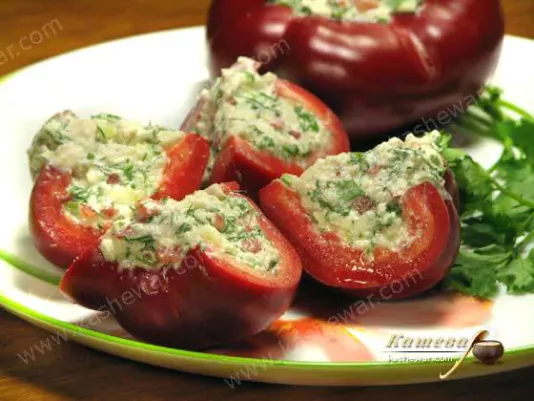Egg Cutlets
Egg cutlets - a recipe of Moldovan cuisine, a very interesting and tasty dish, cutlets are served with any tomato sauce.

Moldovan cuisine is a true reflection of the country’s fertile land, moderate climate, and cultural richness. It was shaped by various peoples yet has preserved its unique culinary identity. The core of the diet consists of simple, accessible ingredients: cornmeal, vegetables, meat, cheese, eggs, and greens. The most iconic dish is mamaliga – cooked in water or milk and served with bryndza, sour cream, pork cracklings, or stewed meat. Soups like zama or borscht are known for their slight tang and generous herbs. Dishes wrapped in cabbage or grape leaves – sarmale – are also popular, as are baked goods like placinte, dumplings, and kulichi. Moldovan cuisine is characterized by long stewing, oven baking, and homemade preservation of fruits and vegetables. Meals are prepared with love in the family circle, and the centerpiece of the table is always bread, wine, and warm hospitality.
Moldovan recipes rely on natural ingredients found in every home. Mamaliga is the main dish served for breakfast, lunch, or dinner. It’s often paired with sheep’s bryndza, cream, fried pork fat, or goulash. Zama is a light chicken soup with a tangy note, usually made with homemade noodles, egg, and plenty of dill. Sarmale are rolled in cabbage or grape leaves, filled with rice, meat, and spices, and simmered in tomato or sour cream sauce. Placinte are round or square pies with a variety of fillings: cheese, cabbage, potatoes, pumpkin, or apples. Desserts often include honey, walnuts, poppy seeds, and raisins. Moldovan dishes are easy to prepare at home, nutritious, hearty, and made to bring families together around the table.
Moldovan cuisine is closely tied to rural life. For centuries, villagers have grown corn, grapes, vegetables, and fruits, and raised livestock and poultry. This shaped the local food – hearty, simple to make, and adapted to seasonal changes. Meals were prepared in ovens, slow-cooked or baked, preserving flavor and nutrition. Preserving for winter – drying fruits, pickling, marinating, making jams – is also an essential part of the culinary tradition. Every rural family has its own recipes for fermented borscht, lecho, jams, and fruit liqueurs. Homemade wine holds a special place – it’s served with most meals and used in sauces and meat dishes. Thanks to the preservation of rural traditions, Moldovan cuisine retains its authenticity and distinctive taste.
Moldova’s culinary heritage was shaped by the influence of many nations and cultures. From the Turks, Moldovan cuisine inherited dishes based on minced meat, spices, and vegetables – dolma, kebabs, eggplant stews. The Balkans brought a love for baked dishes, cheese, corn, and varied pastries. From Ukrainian cuisine came sour soups, beet dishes, aspics, crepes, and pickled vegetables. These influences harmonized with local customs to form a unique cuisine where mamaliga sits beside dumplings, zama beside stuffed cabbage, placinte beside crepes. This diversity enriched the recipe collection and made Moldovan dishes familiar and appealing to many people, especially those living in the historical region of Bessarabia.
The most commonly used ingredients in Moldovan cuisine include cornmeal, potatoes, cabbage, beans, carrots, beets, onions, garlic, herbs, eggs, and meat – especially pork, beef, and chicken. Cheese, in the form of bryndza or homemade cottage cheese, also plays a key role. Spices are used moderately: pepper, bay leaf, savory, dill, and parsley. Dishes are typically boiled, stewed, baked, or sometimes fried in lard or oil. Soups usually feature a light tanginess from fermentation or the addition of whey, borscht starter, or lemon juice. Many dishes combine a starchy base (mamaliga, potatoes) with a protein component (meat, egg, cheese), ensuring fullness and nutritional value. These combinations are typical of traditional rural cuisine, which remains relevant today.
In Moldovan culture, food has a strong ritual significance. For celebrations such as Christmas, Easter, weddings, or christenings, special dishes are prepared – chicken pies, kulichi, meat-stuffed cabbage rolls, stuffed eggs, roasted meat with vegetables. Kutya, honey cakes, and poppy seed pies are must-haves on festive tables. Every family has its own traditions of preparation and serving, passed down through generations. Hospitality holds particular importance: the best food is brought to the table, served in generous portions, with bread, wine, meat, and cheese offered to every guest. Meals are often accompanied by toasts, songs, and ritual acts. Hospitality is not just about food – it is a way to express respect, care, and unity. This makes Moldovan cuisine not only a gastronomic phenomenon but also a vital part of the nation’s spiritual life.